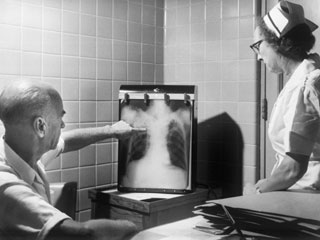By Amanda Gardner
FRIDAY, Oct. 14 (HealthDay News) -- Outbreaks among young people in Texas of the old foe tuberculosis -- often mistakenly dismissed as a long-ago health menace now confined to the pages of a Charles Dickens novel -- show that the respiratory disease is still easily contracted and remains a potential threat to Americans, experts say.
"Tuberculosis has always been with us and probably always will be," said Dr. Len Horovitz, a pulmonary specialist with Lenox Hill Hospital in New York City.
 At least 100 people have tested positive for tuberculosis (TB) on skin tests in Ennis, Texas, about 40 miles south of Dallas, including several students at the local high school. The testing was done after a teacher was diagnosed with TB before the start of the school year.
At least 100 people have tested positive for tuberculosis (TB) on skin tests in Ennis, Texas, about 40 miles south of Dallas, including several students at the local high school. The testing was done after a teacher was diagnosed with TB before the start of the school year. And the University of North Texas in Denton -- about 70 miles away -- recommended that 27 people who had had contact with a student diagnosed with a suspected case of TB also be tested, according to local news reports.
A student at Denton High School also has suspected TB after transferring from Ennis High, although health authorities insist there is no link between the University of North Texas cases and the one at Denton High.
"TB is spread by the respiratory-droplet route, so coughing, talking, singing, breathing, even sitting in front of somebody in an airplane" can put a person at risk, Horovitz explained. "It's air-borne but it has to be in a certain range. It could be in the same room. It's very easily contracted."
While it's no longer the scourge of centuries past, about 11,000 cases of TB were reported last year in the United States, the lowest rate ever. California, Florida, New York and Texas together accounted for half of these cases, according to the U.S. Centers for Disease Control and Prevention.
"When looking at the populations hardest-hit by TB -- racial/ethnic minorities and foreign-born individuals -- both groups continue to be disproportionately affected despite declines," said Dr. Kenneth Castro, director of the CDC's Tuberculosis Elimination Program.
"TB rates for all racial/ethnic minorities are higher than those of whites -- seven times higher for Hispanics, eight times higher for blacks, and 25 times higher for Asians," he added. "Among foreign-born individuals, TB rates are 11 times higher than among those who are born in the U.S."
TB disease is caused by a bacterium called Mycobacterium tuberculosis which typically attacks the lungs. But the germ can attack any part of the body -- such as the kidneys, the spine, and the brain. And if it's not treated with the proper drugs, TB disease can be fatal, according to the CDC.
The highest risk for transmission is among people who live in the same household as well as people in college dorms, barracks and other close quarters, said Dr. Kenneth Bromberg, chairman of pediatrics and director of the Vaccine Research Center at the Brooklyn Hospital Center in New York City.
Children and teens in school settings are at an "intermediate risk," he said.
Encountering people on a bus, subway or airplane is a less common means of transmission, but it can happen.
Just because someone has a positive result on a TB skin test doesn't mean they're infectious or even sick, however. It simply means they've been exposed to the bacterium that causes the disease. These people have a 5 percent chance of becoming sick over their lifetime, Bromberg said.
And "a subset of people with positive skin tests could be infectious," he added.
But the germ is most often spread by people who have symptoms, such as a chronic cough or weight loss.
One recent concern has been the emergence of drug-resistant or even multi-drug resistant strains of TB. These cases are harder to treat. Antibiotics are the usual course of treatment for non-resistant TB.
Health experts divide infection with tuberculosis into two categories: latent TB infection and full-blown TB disease. The CDC estimates that more than 11.2 million people in the United States are living with latent TB infection.
People with latent infection have the germ in their bodies, but they don't feel sick and don't have symptoms because their immune systems are keeping the infection in check. The only sign of potential trouble is a positive reaction to the tuberculin skin test or special TB blood test. People with latent TB aren't infectious, they can't spread the disease and may never develop the disease. But, if the germ becomes active and multiplies, TB disease can result, according to the CDC.
TB disease, on the other hand, means the immune system can no longer keep the bacteria under control. Symptoms can include a bad cough that lasts three weeks or longer; chest pain; coughing up blood or sputum; weakness or fatigue; weight loss; lack of appetite; as well as chills, fever and night sweats, according to the CDC.
People with weakened immune systems -- especially those infected with HIV -- run a higher risk of TB infection than people with normal immune systems.
Currently, there are 10 drugs approved by the U.S. Food and Drug Administration to treat tuberculosis, including the first-line medicines isoniazid, rifampin, ethambutol and pyrazinamide.
More information
For more on tuberculosis, visit the American Lung Association.
